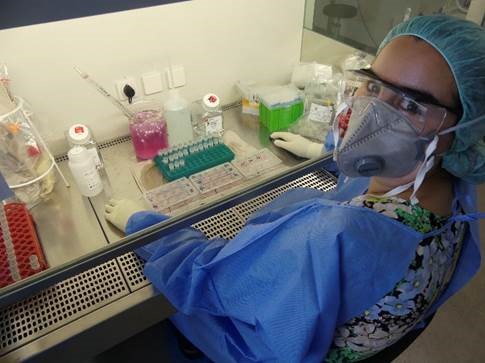How to ZAP the coronavirus – a host protein prompts degradation of viral RNA
Upon infection with SARS-CoV-2, human cells produce proteins that restrict viral replication. One of them, called ZAP, has now been characterized by members of the Institute of Molecular Virology.
When a human cell is infected by the novel pandemic coronavirus SARS-CoV-2, it produces various antiviral factors to defend itself. Some of them may bind to viral messenger RNAs and promote their degradation. A factor that is active against the new coronavirus has now been characterized by a research team consisting of the labs of Frank Kirchhoff, Konstantin Sparrer, Jan Münch and Daniel Sauter (Institute of Molecular Virology) and Steffen Stenger (Institute of Medical Microbiology and Hygiene). Colleagues from King's College in London were also involved in the study.
The main part of the results just published in "mBio" was achieved by Rayhane Nchioua and Dorota Kmiec at the Institute of Molecular Virology. "We were surprised how effectively this cellular factor inhibits SARS-CoV-2 and hope that our results will help to improve immunotherapies against this virus," says Rayhane Nchioua, first author and PhD student in Kirchhoff’s lab.
A protein called ZAP (which stands for zinc finger antiviral protein) recognizes certain motifs in genetic material, so-called CpG dinucleotides. Here, a nucleotide with the nucleobase guanine is directly adjacent to one with cytosine. In the human genome, such sites are much less frequent than one would statistically expect. However, many viruses and bacteria feature considerably more of them. This difference is used by human cells to distinguish between "own" and "foreign" material - in order to know which one needs to be degraded. A comparison with the genetic sequences of more than 200 other coronaviruses revealed that SARS-CoV-2 and its closest relatives from horseshoe bats have unusually few CpG sites. In this respect, the pandemic pathogen seems to have preadapted to humans.
"Viruses try to mimic their hosts," explains Kirchhoff, senior author of the study. Thus, they are at a lower risk of being attacked by cellular weapons - like ZAP. But often, they do not succeed completely. In experiments with human lung cell lines, the researchers could show that ZAP restricts SARS-CoV-2, although the virus offers the protein only a few target sites. "Not the average, but the weakest link in the chain is decisive," says Kirchhoff. That means: Not only the number of CpG sites a viral genome is important, but also where they are located. In the case of SARS-CoV-2, they seem to occur more frequently in some areas that are important for viral replication.
The antiviral effect of ZAP became even more apparent when the researchers added interferons to the cells. These proteins represent a central component of the innate immune system. They trigger numerous defence mechanisms - for example the production of ZAP, as the team observed. If they, on the other hand, reduced the expression of ZAP by using so-called siRNAs, the virus replicated more efficiently. This suggests that ZAP plays an important role in the innate immune response.
How to ZAP the coronavirus – a host protein prompts degradation of viral RNA:


